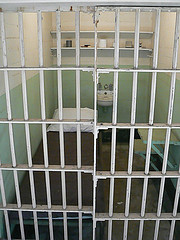 Interesting things are happening in the California penal system. Both sides of the aisle, left and right, have plans for a big change in the way the prison system works. Of course, much of this is being fueled by the massive deficit facing the state.
Interesting things are happening in the California penal system. Both sides of the aisle, left and right, have plans for a big change in the way the prison system works. Of course, much of this is being fueled by the massive deficit facing the state.
It seems that the shortage of cash on the part of the government has those in power trying to find ways to shift the prison population into less costly venues. Michael Gardener, a writer for the San Diego Union-Tribune, explores the details in his recent piece in Sign on San Diego:
The state’s plans to ship low-risk prisoners to local jails could cost counties revenue and are raising fears that inmates may be released early. Transferring non-sex offender prisoners to county jails are centerpieces of dueling plans put forward by Gov. Arnold Schwarzenegger and state Senate Democrats as they scramble to close a $19 billion budget gap.
The foundation of both proposals is to save the state money by offering counties incentives — including cash and greater alternative sentencing authority — to accept more prisoners.
The initiatives are drawing resistance from San Diego County supervisors, statewide law enforcement groups and Republican lawmakers.
‘Counties are very concerned and very suspicious,’ said Greg Cox, a San Diego County supervisor.
A variety of arguments, pro and con, are being presented by both the media and the political class. Suppporters stress that, if implemented, plans like this would give the counties greater lattitude to explore alternative methods such as drug treatment, supervised probation, and others methods that are slowly gaining steam as our prisons fill past the bursting point with mostly non-violent offenders.
On the flip side, the counties are wary of state-proposed programs due to the fact that state payments have usually lagged well behind the costs burden that the programs represent. The cost trail will be important to examine, since it will be one of the major factors fueling this debate. Another one, and by far the most important from a human standpoint, is the offenders themselves. While the phrase “early release” ring warning bells for many in California, it is important to examine whether these people truly need to be incarcerated.
What are your thoughts? If you live in California, we would particularly like to hear your pros and cons on this subject.
Source: “State’s plans to send prisoners to county jails worry officials,” Sign On San Diego, 08/25/10
Image by Tim Pearce-Los Gatos, used under its Creative Commons license.
Visit Us on Facebook: Humane Exposures Publishing , downTownUSA, Maggots in My Sweet Potatoes, It’s More Expensive To Do Nothing

 So many issues trace back to childhood. The opportunities, the lack thereof, early life traumas, and all the other factors that can impinge on early life, create the building blocks from which the adult is sculpted. Educational opportunities are particularly key, especially during the early years when the mind is so hungry for knowledge.
So many issues trace back to childhood. The opportunities, the lack thereof, early life traumas, and all the other factors that can impinge on early life, create the building blocks from which the adult is sculpted. Educational opportunities are particularly key, especially during the early years when the mind is so hungry for knowledge. It is no secret that American schools are in deep trouble. Programs touting major turnarounds in the system seem to pop up regularly in urban and rural areas everywhere. No Child Left Behind (NCLB) is one of those programs, one which has received both positive and negative press. Today, we are going to take a quick look at one of NCLB’s early attempts:
It is no secret that American schools are in deep trouble. Programs touting major turnarounds in the system seem to pop up regularly in urban and rural areas everywhere. No Child Left Behind (NCLB) is one of those programs, one which has received both positive and negative press. Today, we are going to take a quick look at one of NCLB’s early attempts:  HUMAN
HUMAN Pennsylvania has had its woes when it comes to its juvenile justice system. One of the worst and highest profile problems it has suffered was the much publicized “Cash for Kids” scandal. Here is a condensed rundown via
Pennsylvania has had its woes when it comes to its juvenile justice system. One of the worst and highest profile problems it has suffered was the much publicized “Cash for Kids” scandal. Here is a condensed rundown via  One of the persistent issues in the American penal system is that it is massively overcrowded. A plethora of reasons for this abounds, as a simple Google search will show. The solutions have been in shorter supply.
One of the persistent issues in the American penal system is that it is massively overcrowded. A plethora of reasons for this abounds, as a simple Google search will show. The solutions have been in shorter supply.
 It is no secret that the American prison system is rife with problems. It is the personal stories of women in our penal system that led our own Susan Madden Lankford to create
It is no secret that the American prison system is rife with problems. It is the personal stories of women in our penal system that led our own Susan Madden Lankford to create  There are many social obstacles for the homeless. Things that we take for granted in our day-to-day lives may suddenly become seemingly insurmountable problems. In many cases, it can turn out to be something no one thinks of.
There are many social obstacles for the homeless. Things that we take for granted in our day-to-day lives may suddenly become seemingly insurmountable problems. In many cases, it can turn out to be something no one thinks of.








